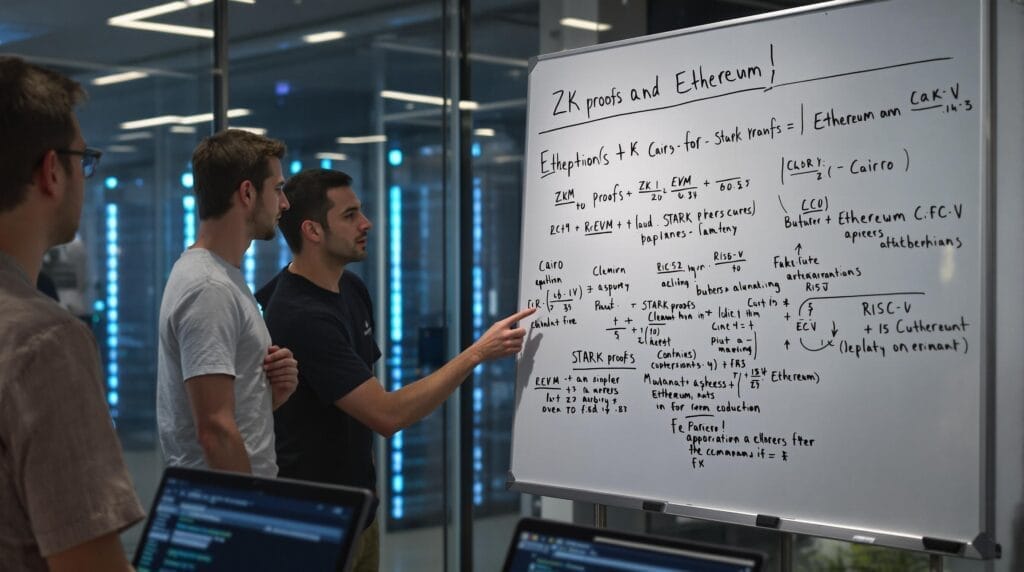Something interesting is happening in the world of Ethereum. A company called Kakarot, which has support from Vitalik Buterin, one of Ethereum’s creators, and also from StarkWare, a company focused on making blockchains bigger and faster, says they’ve built something big.
- Kakarot, supported by Vitalik Buterin and StarkWare, has built a zkEVM using the Cairo language with the goal of proving Ethereum blocks in real-time. This could significantly improve Ethereum’s scalability and efficiency by validating transactions quickly and securely.
- Kakarot’s approach differs from many zkEVMs that rely on the same EVM code, instruction sets, and proof-making tools, aiming to reduce systemic risk by using a unique system. This variety is seen as beneficial for the overall robustness of the Ethereum ecosystem.
- The company aims to create STARK proofs for each new Ethereum block faster than the block creation time, and this is viewed as a critical step towards Ethereum’s future reliance on ZK proofs. Kakarot has received $6 million in funding to achieve this goal.
They’ve finished what’s called a zkEVM (that’s a zero-knowledge Ethereum Virtual Machine, basically a way to run Ethereum programs but prove everything happened correctly without showing all the details). And they built it using a special language called Cairo.
Their big goal? To prove every single Ethereum block in real-time using something called STARK proofs (a type of zero-knowledge proof that’s good for speed and transparency). They want to do this by the end of 2025.
Think about it. Ethereum makes a new block every 12 seconds. Kakarot’s co-founder and CTO, Clement Walter, said they plan to create a STARK proof for that block within just 8 seconds. That’s faster than the chain itself makes the block. He called this the kind of speed and toughness Ethereum needs.
This Kakarot zkEVM uses StarkWare’s tools to make these proofs and send them back to the main Ethereum chain. The main idea is to make those Ethereum smart contracts (the little programs that run on Ethereum) work better and faster, all while proving every transaction is totally valid.
Ethereum’s plans for the future, looking out to 2028, really depend on these ZK proofs. Kakarot is saying they’ve built what they call the “first credible alternative” way to make these zero-knowledge proofs for Ethereum blocks. They aren’t using the same setup everyone else seems to be using.
It turns out, many of the zkEVMs out there right now use a lot of the same basic parts. They often use the same EVM code (called rust-evm), the same set of computer instructions (called RISC-V), and the same proof-making tool (called Plonky3). The Kakarot team explained this is a bit of a risk, like putting too many eggs in one basket.
Kakarot wants to fix this risk. By using Cairo, they reduce how much they rely on just one system. It’s like having different kinds of engines for different cars; if one type has a problem, you still have others that work fine.
Justin Drake, a researcher at the Ethereum Foundation, likes this. He said Kakarot’s different setup – no Plonky3, no revm, no RISC-V – is great for having more variety and trying new things in the zkEVM space. He compared it to having different software clients running the Ethereum chain; having variety makes the whole system stronger, even if one part has bugs. It helps make the move to using ZK proofs everywhere more solid.
Eli Ben-Sasson, a co-founder and CEO at StarkWare, thinks Kakarot will be a leader in the race to get real-time ZK proving working on Ethereum. He believes Kakarot has a “superpower” because it uses a language built specifically for ZK proofs, that’s Cairo.
He also pointed out the diversity part again. Everyone talks about being ready for ZK proofs, but if everyone uses the same tools, it’s a shaky promise. Kakarot gives Ethereum another option, another path forward for its ZK setup.
Talking About RISC-V
This news from Kakarot comes after Vitalik Buterin recently suggested something pretty big. He floated the idea of maybe swapping out Ethereum’s current EVM code for the open-source RISC-V architecture to help it handle more stuff.
Vitalik called this idea “radical” and “ambitious.” He even said it might be the “only viable path” to really make Ethereum’s execution layer scale up a lot. He thought it could cut down the cost of running things on the chain by a huge amount, maybe even 100 times less in some cases. He added that older Ethereum programs would still work and could easily talk to any new ones built with RISC-V.
Kakarot’s CTO, Clement Walter, had something to say about this on Tuesday. He agreed that using a set of computer instructions that works well with ZK proofs makes sense for running things on Ethereum. But, he added, there’s no need to rush into using RISC-V specifically.
Walter said Kakarot’s announcement shows that people shouldn’t feel limited to just reusing the tools that are already out there. He believes they can build a system that’s really fast and made just right for what Ethereum needs.
The Kakarot team is based in Paris and has about 10 people. They got $6 million in funding from people deeply involved in crypto, including Vitalik Buterin and StarkWare. They started as a community project, basically writing down how Ethereum works using the Cairo language, and have grown into a company building core blockchain stuff for the future.
In other Ethereum news, the Ethereum Foundation recently shared who is in charge now, with new executive directors and board members. This was posted online just before the planned Pectra upgrade for the main Ethereum network, which is supposed to happen on May 7. That upgrade is meant to make things easier for users, help those rollup systems scale better, and even raise the limit on how much crypto validators can stake.

